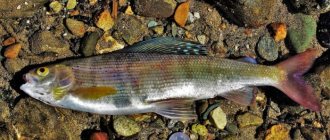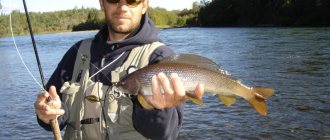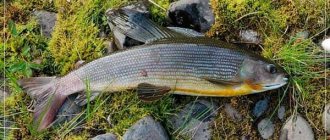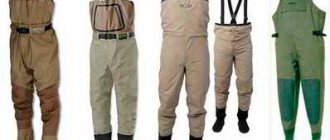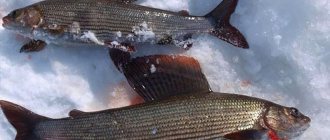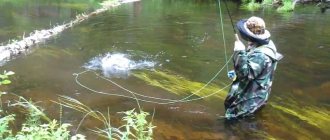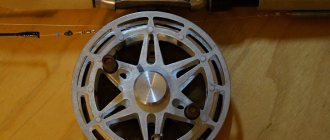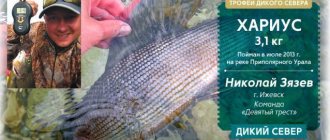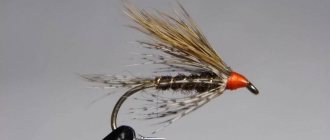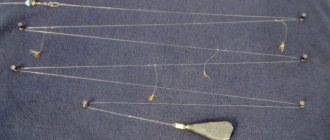Design Features of Gossip
In essence, gossip is fishing tackle that is created directly on the fishing line of the spinning rod used. The fishing line combines two floats, one of which is of greater mass for effective immersion of the tackle when casting and its easy movement along the surface of the reservoir. Along the entire section of the fishing line, leashes with flies are evenly distributed between the floats. Their number may vary, but on the longest structures about 7-10 pieces are used. A lighter float prevents the line from sagging in a certain area.
As practice shows, gossip can be used with equal effectiveness regardless of the speed of the flow. The time of day, as is the case with many fish species, makes its presence felt as most of the catch occurs in the evening when potential prey are playing near the surface. Fish do not leave reservoirs throughout the warm spring-autumn period. Gossip has a high fishing efficiency, but is not decisive among other types of gear.
Making gossip with your own hands
It is worth noting that creating gossip fishing tackle with your own hands is quite simple. The main condition is a durable fishing rod and the reliability of other components.
Experts recommend using:
- plug-in graphite spinning rod with a length of at least 3 meters;
- a reel similar to an inertia-free one, with a front clutch manufactured by Daiwa or the same;
- The main line is braided with a diameter of 0.17 millimeters.
The gossip itself is created on a monofilament fishing line with a diameter of 0.4 millimeters and a length of 250 to 280 centimeters. You can use pieces of foam plastic as floats: one no larger than a chicken egg, and the second the size of an orange. The larger one is located at the end of the tackle, and the smaller one is at the beginning. The gossip itself is secured to the main fishing line using a carabiner in order to be able to replace it if any component of the gear used is damaged.
Attaching flies
When the technical part of the gossip is ready, we can begin to secure our bait. For the standard distance indicated above, you can use 5-6 pieces, distributing them along the entire length of the fishing line every 30-35 centimeters. They are secured with small leashes. It is important that the leashes do not intertwine with each other, since the fish is smart and can avoid such webs.
Technical characteristics of such mounts:
- the diameter of the fishing line for leashes is 0.08-0.1 millimeters;
- The length of the leash should be changed in accordance with the season: spring - 12-14 centimeters, and closer to summer warming it can be reduced to 8-10 centimeters.
The nuances of creating and exploiting gossip
It’s worth noting right away that without flies this tackle is useless. As mentioned earlier, the fish will not react to the fishing line and, on the contrary, will try to swim away from it. It is very important to make bait that the fish will bite on. Here you can only rely on your own observations, since the fish will react to those insects that fly during the fishing period. For example, if a mayfly is actively moving, then the flies should be fully consistent with this species.
To determine a suitable bait, the search method is effective: several types of flies are attached to the fishing line at once. Three flies should have different light shades, and the other three should have different dark shades. Thus, the fish will not keep you waiting and will notify you of its preferences. Certainly no one forbids you to experiment with bait, and this will not be a problem for a professional who always has a supply of flies.
Installation of flies
After completing the technical part, the gossip moves on to attaching flies - bait. For such a distance, as indicated above, it is enough to use 5-6 flies, which are distributed along the entire length of the line every 30-35 cm. Installation is carried out using leashes.
Artificial flies have versatility; with their help you can catch not only grayling, but also other fish. These are durable baits with a long service life.
For information! During the manufacturing process of the tackle, it is necessary to ensure that the leashes do not get confused with each other. Otherwise, a cautious fish will simply bypass this tangled ball.
For fastenings use:
- fishing thread with a cross-section of 0.08-0.1 mm;
- The length of the leash varies depending on the fishing season (in spring it is enough to use leashes 12-14 cm long, and in summer their length can be reduced to 8-10 cm).
Tips for use
- In this case, tying flies is mandatory; without such bait, this tackle becomes useless. The grayling just won’t react to the fishing line.
- The bait for a predator should be as attractive as possible so that it can be immediately noticed. The key point here will be the presence of insects during a specific fishing period. For example, if a mayfly actively moves over a pond and in large numbers, attracting the attention of fish, then the chosen bait should be fully consistent with this type of insect.
- The best option for equipping a gossip is to use several types of bait simultaneously. You can take three things with a light color and three with a dark color. The predator will immediately react to such tackle and inform about its taste preferences.
- A fisherman should have several options of flies in his arsenal in order to identify the most catchable bait through experimentation.
Gossip catching technology
Since we are already talking about the fact that the main fish for such tackle as the gossip is grayling, then it is very important to know its habitat. Individuals can be located on both sides of a riffle, stick to the currents behind stones, or choose a pit. When a place has been chosen, it is necessary to cast it correctly and not deviate from the technology of guiding the tackle in the future.
The design of the gossip allows you to make the longest cast from the shore without stepping into the water. It’s worth casting hard, with the tackle pulled behind your back, but remember about safety precautions: the hooks should not touch the ground or the fisherman, so that they don’t get caught on clothes or, even worse, create an injury out of the blue.
When the cast is made, the tension of the fishing line needs to be controlled with the reel (it should be maximum), and the movement of the gossip will be carried out due to the current in the reservoir. Attached flies imitate insects that have fallen into a pond. All that remains is to follow the floats, which will let you know about the bite. It is quite possible that you won’t even have to hook the fish, because... It rushes at prey sharply and very often gets hooked itself.
Experts come to the conclusion that there is no particular advantage in fishing with gossip, but at the same time, the simplicity of its creation provides unique opportunities for novice fishermen who do not have to spend their own money on purchasing expensive equipment. Also, you will not need to urgently learn the various nuances of fly fishing or float fishing. It works best in shallow waters.
comments powered by HyperComments
plotka.ru
“Long-Range Eggs”, or Floats for Gossip # OWN CURVES
Hello, PhishingSib readers! While preparing now for the annual mountain fishing, I noticed that the stock of loaded floats for long-distance casting, which are traditionally equipped with such gear as gossip (emphasis on I), is small. Their consumption, in principle, is negligible, but either friends “pulled up” over the winter, or “rolled” somewhere... In general, I took up the “saw and hammer”!)
NOTE: “The photo schematically depicts gossip so that the reader immediately understands: what, why and why.
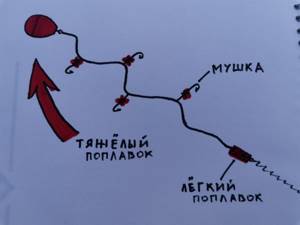
This is a kind of “garland” of fly fishing “flies”, connected from fishing line. Cast using a rod with guides and a reel. The float, which will be made in this article, serves precisely for casting equipment. It is sometimes called "bulda" or "egg". The second float (usually small) serves to ensure that the entire structure is on the surface of the water, or in the very surface layer.
So, this gossip is floated in a “straightened” state along the river, in the places where the fish are supposed to stop. The fish sees the “flies” and – ah!) It’s simple)
The main fish caught with the help of gossip on the rivers where I fish is grayling. It is for this reason that all the handicraft described below...)"
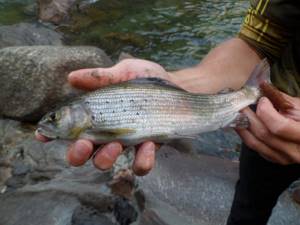
FLOAT.
Let's get started! I use the following construction and finishing tool as the material for the float. Or rather, its handle.
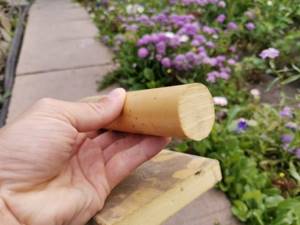
The material of this instrument has a very high positive buoyancy. In addition, it is lightweight, durable, affordable and easy to process.
We cut the handle “in portions”. In my case, 45-50 mm. This size of float goes well with a weight of 12-14g, which in turn goes well with the rod that I’m going to use to cast the fish.
NOTE: “Another undeniable advantage of home-made floats is that the weight can be made specifically for your fishing rod. Let's say your fishing rod is up to 21g (like mine, for example). It is very possible that “test” floats will not be available for sale at all. In the Altai Mountains, they mainly catch gossip with powerful “sticks” (even without quotation marks), so “heavy eggs” weighing about 40 grams are in use... In the photo, a friend purchased it there. No one has found it useful yet...
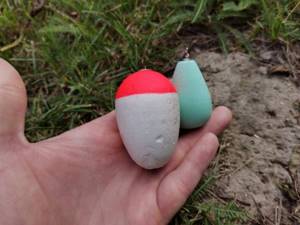
And the price in those very Altai Mountains for gossip and all the equipment elements... Ugh, in a word... At this point I say hello to Ivan (Predator123)!)))"
Let's get back to the crafts. Next, I use a stationery cutter to remove the top layer from the blanks. Like potato skins). This will simplify further processing. Again, you can slightly reduce the diameter of the workpieces to the required size in advance.
For the next operation, you will need a long (or medium-length) self-tapping screw without a “cap”.
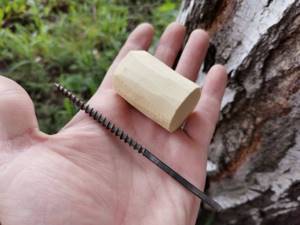
We mark the center at the end of the workpiece. We screw (directly by hand) the self-tapping screw into this center, maintaining perpendicularity with respect to the end cut, leaving a “reserve” of 10-15mm in the workpiece. And now, as everyone has already guessed, a self-tapping screw into the screwdriver chuck (drill, hammer drill).
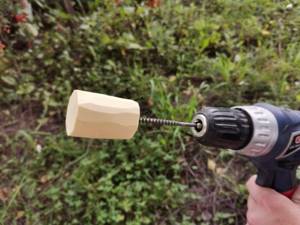
We begin turning with coarse sandpaper. The material is pliable and easy to process. Give it the desired shape (for example, “egg” or “drop”).
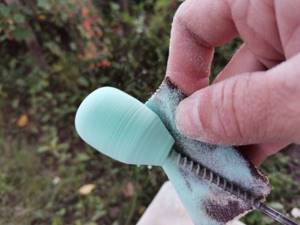
Smooth (if desired) with fine sandpaper. The “eggs” already look like themselves. Next is filling and assembly.
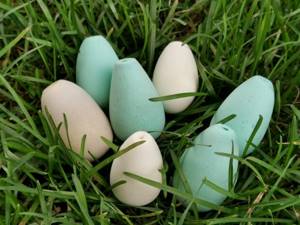
LOADING AND ACCESSORIES.
I will load the float with an ordinary “eared” weight. In this case, 12, 14 and 16g. The material for the axle is wire for semi-automatic welding machines. Diameter – 0.8mm.
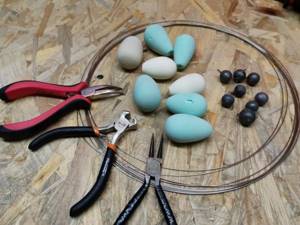
I bite off one of the “ear” weights and a piece of wire 12-15 cm long. In the other ear I insert a loop made at the end of the wire, which I wrap “tightly”.
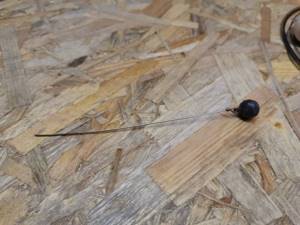
Now let's get back to the floats. In the “lower” part you need to make a recess into which the lead weight will be hidden. You can work with a knife. I have a mini drill with a suitable attachment for this operation, so the whole procedure takes 30 seconds.
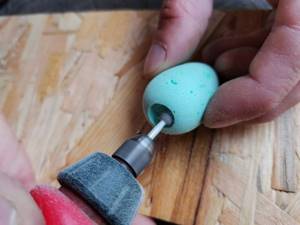
Test fitting... The weight is in place. Usually the hole from the screw becomes visible. The axis will then pass through it.
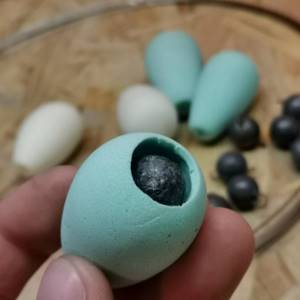
So... Now it's time for aluminum drink cans. And again, as in my last article on homemade products, you will need the metal bottom of the can. We cut out washers from it, similar in diameter to the “upper” end of the float. Maybe less. Make a hole in the center.

It should look something like “like this”)
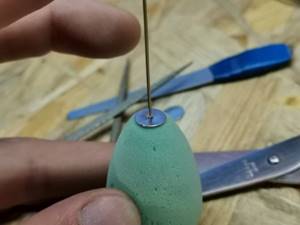
ASSEMBLY.
I’m starting to collect the “balda”. I mix two-component epoxy glue (I use EDP-2) and generously coat the entire cavity under the weight, after inserting the axle.
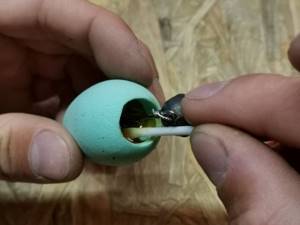
Then I pull the axle outward with pliers, thereby driving the twisted wire along with the glue into the float material. I put glue on the outside.
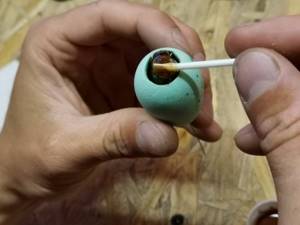
I send the workpieces for drying. Usually 3-4 hours
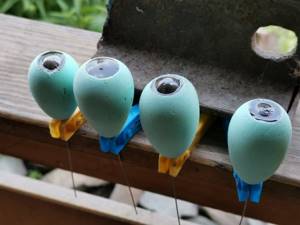
And after drying, all that remains is to put on the washer and make another twist, resting its last turn on this very washer.
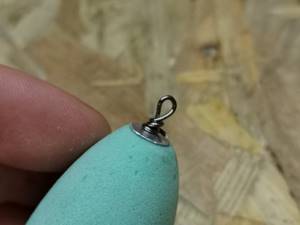
We process the twist with a file. All. The floats are completely ready for use. If you wish or it’s Easter Eve, you can paint it). And yes... It’s better to check buoyancy before fishing!)))
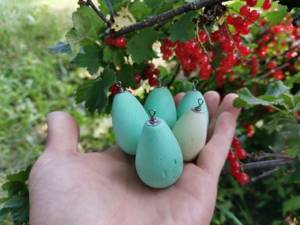
ABOUT APPLICATION.
This float is a highly specialized thing. Its purpose is to deliver and transmit gossip. She copes with this very well and has brought me excellent catches more than once. The float flies very far and accurately, placing the equipment precisely in those riffles that you see as more promising.

But the gossip itself catches not only on mountain rivers. I know that my friends use this gear to catch ide feeding from the surface on the Ob River. And on the middle rivers of the NSO, bleak is excellently caught. So, I recommend trying it!)
Thank you for your attention!)
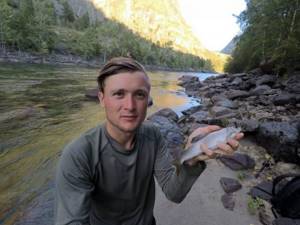
Proper fishing for grayling using riding gear
The surface method got its name because the baits are slightly recessed from the surface of the reservoir. The fact is that if there is a sufficient current, floating flies throw away traces of which the fish are afraid. To eliminate it, a shot is attached to the outer front sight; it slightly submerges the equipment.
This attitude works best in the summer, when there are a lot of flying and crawling insects near the reservoir. If the riding tackle is used in the spring, immediately after the ice melts, the flies are tied in dark colors, since at this time the broom larva appears on the shore, and then the mayfly. But when poplar fluff starts to appear, preference is given to light colors, masquerading as a bark beetle.
In the heat, the number of colors increases significantly, the main thing is that the corresponding insects are found on the river. The riding attitude can be used both on a small river and on a huge reservoir. The float is made from wood of conical geometry, it is weighted with lead and a monofilament is placed with bends to the sides, to which dry flies are tied.
Catching grayling with riding gear occurs as follows: cast the rig opposite you, then, slightly tilting the fishing rod, reel in such a way that the bait is slightly sunk. In this case, the monofilament must be taut, holding the weld from the starting point to the ending point.
Since grayling perceives a fly as a living object that can disappear from sight at any second, the bite occurs abruptly. Since the float is under some resistance to the water due to the tension of the fishing line, the hooks easily hook the fish.
That is why no twitching of the fishing rod, much less hooking, is required. Rising to the surface, grayling quickly grabs the bait and instantly rushes to the bottom, dragging all the equipment with it, including the wooden float. The disadvantage of riding gear is that frightened fish, observing the unusual behavior of a relative, stop taking it.
To avoid empty castings, casts have to be made in different directions over short and long distances, and after fishing the area it is necessary to move to a new place. Unfortunately, when fishing, there are many empty bites and even fish disappearances.
The fact is that the hook is positioned with the tip down and when biting it pierces the lower lip of the fish, which is much weaker than the upper. Trying to avoid such cases, fishermen knit tees and doubles. This somewhat reduces the number of strikes, but at the same time the bites are also reduced.
Fishing on a boat
Perhaps the oldest and most proven method of catching grayling is with a boat (or sleigh). What are the advantages of this fishing method? One of the important points when fishing for grayling is the correct selection of flies. Color, size and shape are all very important factors when catching fish.
But how hard is it to guess what grayling will take today, what kind of bait it will like? With the help of a boat, you have the best chance of finding out which fly the predator prefers, since when fishing with a boat, you can use up to 15 flies at the same time.
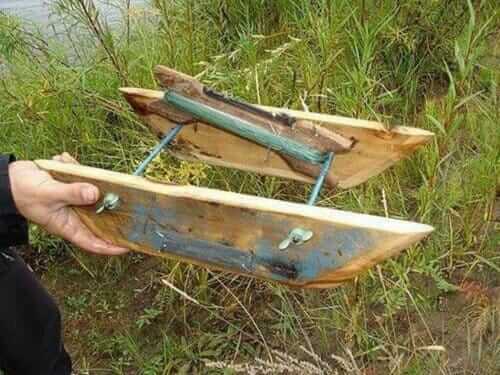
It is best to place flies in different colors, but we should not forget about the shape of the bait. The fly should be as similar as possible to a natural insect, both in body shape and color. Grayling has excellent eyesight and if he notices a catch and the bait does not imitate a natural insect, then the fisherman is unlikely to see a bite.
With the help of a boat, you can easily hover at the desired perspective point next to a riffle or on it itself, which helps provoke grayling to bite. Another advantage when fishing with a boat is that you can catch more than one specimen in one launch.
There were cases when in a few minutes 7-8 fish landed on different flies at once, and the size of such fish was at least 300 grams.

One of the convenient techniques when using a boat is to launch it at the desired distance and fix it at this point (for example, tie it to a small tree that is located near the edge of the reservoir), while you can calmly sit and watch, waiting for the fish to bite.
How to make riding tackle for grayling yourself
Fishing for grayling using artificial flies has been going on for many years. But fly fishing doesn’t take root everywhere due to a number of factors, including the high price of gear, the difficulty of making it yourself, and limited use. All this forces fishermen to look for their own ways to catch the predator.
On small rivers you can use a short fly rod with a monofilament line with a cross-section of 0.35-0.4 mm. The end of it is knitted with a loop, to which a meter-long leash is mounted using the “loop to loop” method. Its cross-section is 0.18-0.2 mm. A 5-7 cm float is attached above the leash mounting using a slip-on loop.
An artificial fly is tied to the end of the leash, made on a number 4-5 hook. The color of the bait must be similar to the color of insects that are present near the water during this period of the season. Brown, black and gray shades are suitable along with rooster feathers.
Riding tackle for grayling, the manufacture of which is slightly different for fishing on decent rivers, is made of a larger size because the casting distance increases. The main leash reaches two or more meters, the cross-section of the monofilament is 0.25-0.3 mm. No more than three side branches are made under the flies, and the length of the float reaches up to 15 cm.
Casting such equipment is carried out with a spinning fishing rod with an installed inertial reel of the “Nevskaya” type. It is enough to place monofilaments with a cross section of 0.4 mm on the reel within seventy meters. The scaffolding must not only be strong to break, but also very flexible, which will prevent it from breaking when it runs across the drum.
70 meters is exactly the necessary threshold, which, if exceeded, leads to an increase in the mass of the reel and, ultimately, an increase in centrifugal force, which, ultimately, is fraught with various troubles, including overrunning and the formation of beards.
If you have to fish on rivers with fast currents and significant depth, knit a 4-meter leash with a cross-section of 0.3 mm. The number of side leashes is increased to four pieces, made on 0.25 mm line. The surface float in this case can reach twenty centimeters. To cast weighted equipment you have to use an elastic and durable spinning rod with an appropriate reel.
Riding spirit with float
This is one of the varieties of equipment designed for grayling. The float is made with your own hands; it is similar to the bombarda, which we talked about in the article “Bombarda: catching a predator on a spinning rod with ultra-light baits.” Attach it to the end of the central fishing line.
- Small leashes with flies are knitted a little higher, in another version they are placed at the end of the central cord. To make a float, it is permissible to use wood or foam plastic. Any other source material that can float is also suitable - plastic, rubber or cork.
- The shape of the float is cone-shaped; it is surrounded from below with a lead so that it sticks half out of the water. The length of the setup is within one meter, since fishing with longer gear is not entirely convenient. Leashes - two or three from sections of line 6-8 cm and a cross-section of 0.18-0.20 mm. The thickness of the main cord is 0.30 mm.
- For riding, a spinning rod of 2.7-3.0 meters is used; a more bulky rod is quite difficult to work with, since fishing is often carried out on banks overgrown with abundant vegetation. The spinning rod can be equipped with a spinning reel.
A fish bite is expressed by a sharp pull, sometimes by a blow. Flies are often grabbed by two individuals at once, so do-it-yourself riding tackle for grayling should have a certain margin of safety. They fish from the shoreline, throwing bait onto the riffle, then lower it around the circle, slowly picking out the line until the tackle carries it to the shore.
Types of gear for fishing grayling
For grayling, residents of middle and northern latitudes use both classic and interesting types of gear, adapted for hunting this omnivorous fish.
What gear is best for catching grayling:
- float tackle for grayling is most popular and effective when fishing in small rivers. Usually blind equipment is used on a thin fishing line of 0.2 mm with medium-sized hooks No. 4-7. The preferred rod length is 4-4.5 m with a fast action for comfortable hooking. We take a sinker weighing 1-1.5 g and a float 2-3 g. The bait depends on the reservoir, but the most common baits are: worms, beetles, gadflies, grasshoppers, flies, pieces of fish, etc.;

Fishing for grayling can differ significantly from each other even in the same region of the country
- Spinning tackle for grayling fishing is distinguished by its catchability and range. When choosing a fishing rod, we take a spinning rod 2.4-2.8 m long with a flexible tip and a test weight of less than 10 g. We choose an inertia-free reel, although inertia reels are in demand in Siberia. We prefer thin fishing line, about 0.2 mm; if we are talking about braided line, we take it even thinner. Many lures for grayling show good results, but we definitely take them small. The key to the catchability of a spinning rod is the correct choice of wiring: surface or in the water column, depending on the habitat of the intended prey;
- American tackle for grayling. This is a common name, in fact, “American” is the same “bulda” or running donkey. More often it is used not in the classic version, but in the Siberian version, also called cargo tackle for grayling. Setting up a load for grayling with your own hands helps you fish difficult areas: rapids, riffles, points near rapids. During production, a sinker of 40-80 g, a set-up (base 0.5-1 m with 2-4 pcs. of fixed leashes), and a submerged float are usually used. In order for the float to fulfill its role in the cargo setting, its buoyancy force must exceed the weight of the gear by 1.5 times;
- Tyrolean stick tackle for grayling. “Tirolka” is effective in fast currents, but in stagnant water it turns out to be useless. The stick acts as an underwater float combined with a load. A lead weight is inserted into it from below, and the upper part is made of sealed plastic. After casting, the side with the load is adjacent to the bottom, and the second is directed upward; we attach the main fishing line or leashes to it. To make the tackle, we take a rigid rod 2.4-2.7 m made of carbon fiber with a dough of 100-120 g. We take a reel with a spool from 2500. As a base we take braid with a diameter of 0.15 ± 0.03 mm;
- The “gossip” tackle for grayling consists of 2 cigar-shaped floats, connected to each other by a fishing line to which small leashes of 3-5 cm are attached. We install as many leashes with flies as we wish, but casting dozens of flies is inconvenient, so it’s better to limit yourself to 5-7 PC. The tackle is easy to assemble, but casting becomes more difficult; for this purpose, we install a sinker to the final float. By making floats ourselves from polystyrene foam, we can place the load inside the float. For fishing with such gear, a spinning reel, a 4 m long rod of medium action and a 0.25 mm monofilament are often used.
You will have to make a specific choice on what gear to catch grayling on yourself, since the characteristics of grayling fishing in a particular body of water are strongly influenced.
How to tie a simple fly for grayling
Fishermen have become quite successful in tying artificial flies. They were forced to do this by difficulties with obtaining and storing natural bait. Having achieved a certain mastery in their craft, they realized that, having a minimum of materials available, they could make excellent imitations with great success.
All baits are conventionally divided into two categories. Dry ones resemble the behavior of insects that have entered a body of water from the outside - moths, dragonflies, wasps, flies. Their characteristic feature is fluffy plumage, which is achieved using bird feathers and animal fur. The hooks chosen are small, made of thin wire.
Wet flies are similar to animal objects that live directly in the reservoir - beetles, tadpoles, caddis flies, larvae, pupae, nymphs. In this case, a minimum of feathering is used in combination with thick hooks. To increase the mass, metal wire is often used.
In each body of water, fish have their own food supply, to which they have already developed a habit over the years. At the same time, there is no point in dipping in spring water those imitations of animal objects that will appear only in late summer. That is, the flies offered at a given moment must correspond to their time.
- Many fishermen prefer imitation caddisfly, which is used both on lakes and in mountain rivers. In addition, this bait is considered all-season.
- In the spring, sometimes they use bait that imitates a mayfly. When fishing in a reservoir at the moment the insect takes flight, it is possible to get a decent amount of fish.
- In summer, grayling is hunted with the help of a nymph. At this time, the fish disperses at the very bottom or in the middle horizons, and the smoothly sinking bait is happily attacked by a predator.
- The bunting larva is considered a universal bait. They use it throughout the open water season, the main thing is to guess the colors in a given period of time.
Tying a simple fly yourself is not difficult. The tools you need are small vise, tweezers and scissors; the components you will need are wool, feathers, beads, thread and glue. The manufacturing sequence is as follows.
We clamp the hook in a vice and string a bead onto it, which will act as a head. We wind a black thread onto the forend from the bead to the bend. This will be the backing. To make a tail, you will need a bird feather. Four barbs are placed on the hook and wrapped with thread to the head of the bait.
At the bead itself, unnecessary parts of the feather are cut off, then the thread is pulled in the opposite direction. The body of the fly is made from diving, it is first placed on a thread, then turns are made in two layers on the fore-end. Having applied the feather of the bird, the beards are pulled away from the head and the front part is secured with thread.
After this, the feather and thread are wrapped several times around the fore-end. The thread is wound near the head. The feather is straightened with scissors, removing what is unnecessary. To firmly fix the thread, it is coated with waterproof glue. The result is the simplest version of a fly for catching grayling.
www.udim.ru
Catching grayling with a classic dry fly is now problematic, but catching it well with a fly is good. The large float is made of foam plastic, its length is 80 mm, diameter is 40 mm. The length of the working equipment depends on the length of the fishing rod and is usually 1.5-1.8 m. If you make it even longer, the equipment will become poorly controlled. The flies are placed on the rig 25 cm from one another.
The small float is made in the form of a truncated cone. Its length is 40 mm, the diameter of the larger base is 25 mm, the smaller one is about 5 mm. With such dimensions, the dynamic resistance of the water will be sufficient for the grayling to be reliably detected when biting.
The gossip is intended as a tackle for fishing with weighted wet flies, but I’m on the river. Ursul also used dry ones with success.
Tying flies has its own characteristics. The leash, after tying it, should be directed against the current. This is easy to do by tying it with a figure eight.
Unfortunately, it is difficult to find flies tied on tees on sale. However, they showed me an original technical solution that allows you to orient the front sight tip in space. A 0.4-0.5 mm fishing line is passed through the ring or hook weight, and a knot is tied at its end. The front sight is oriented like a weather vane, with its tip downstream and upward.
The manufactured gossip is tied to the main fishing line through a swivel. They are usually caught with a rod 2.7 m long or more, with 50-90 g of dough, equipped with a spinning reel.
The equipment should fall after casting slightly higher than the section of the river being fished. The fishing line is reeled in so that when the floats float against the fisherman, they are stretched out in a line perpendicular to the shore. The rod should be held almost vertically. The line layer is open, the line is released, holding it with the index finger, trying to ensure that the area being fished is maximum, and the line between the floats is stretched and moves frontally with the flow.
If the current speed is high, as happens on mountain rivers, then you can feel the bite with your hand. In cases where the rig is moving along a section of the river with a slow current or in a quiet area behind a natural obstacle, the bite can be noticed by the convergence of the floats. It is not recommended to hook sharply, since the lips of grayling are weak.
When fishing, the tip of the rod is lowered to a height of up to 1 m and the fish is carefully pulled in without forcing events. The speed of the current must be taken into account. If necessary, you can move towards the prey down the shore.
Using this gear, you can fish the river with long casts; this is important, since grayling is quite shy, especially in frequented sections of the river. The wiring range is limited by the ability to control the tackle and unimpededly pull it back.
As you know, at different times of summer, day, depending on the water level, fish prefer different flies. If it is not possible to consult local fishermen on this issue, then, having noticed the most catchy flies, you need to put 3-4 such baits on the gossip. You can experiment with the rest: put different colors and sizes, change sinking flies for dry ones.
spinningist.info
